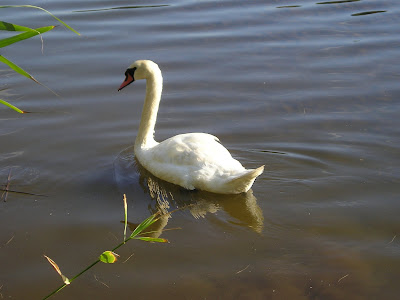This post is more about the story than the photography, since I was using my Olympus (now carried at all times in my purse, for moments just like these). The experience I found touching and sweet, and just another example of what it means to be and have a family - dedication, nurturing, innocence and protection - are never far from us.
Last week, I was driving back from a shopping trip, and decided to stop and take some photos along a small bridge that passes over a creek opening up into an inlet. Small private boat docks line the right hand side, and there is a public paved trail that is on the left that I'd never taken.
As I go over to the bridge, I see a family of swans resting on a small rocky bar in the inlet. It's the time of year that the cygnets (young swans) are seen more often as the parents take them out. Noticing the path, I decided to follow it to see if I could perhaps get closer to the swans and get some photos; I've only seen the babies a handful of times and always far away.
I found that I could stand up on a concrete wall next to the pathway and see over the reeds to the swans. Having enjoyed part of their afternoon on the sandbar, they headed for the water: babies, mom, with dad following up the rear.
Much to my amazement, they soon turned and headed right towards the opening in the reeds near where I was standing! At this point, dad is now leading the way. They keep right on coming. I jump off the wall, and not wanting to scare them off, slowly go through the reeds onto some flat rocks that lead right to the edge of the water where I can get a better view and hopefully some better pictures.
For those not familiar with swans, those found in this region are Mute Swans (Cygnus olor), introduced from Europe and Asia. While they are beautiful, elegant birds, they are large and can be very aggressive towards humans; a day after I took these photos, I watched a large male swan block a guy from getting back into his car near the small boat ramp he'd parked to watch the swan and its family over along the Mystic river. It then proceeded to bang its bill on the rear window of the car when one of the kids tapped on the window. They will also hiss when angry or threatened...or maybe because you didn't give them any food.

Knowing this, I definitely didn't want to provoke them, possibly risking an attack. So, I stood quietly and watched. Both mom and dad hissed at me, as a warning, probably. The cygnets paid no attention, and immediately got to the business at hand: eating! They eat plant material, and these photos show that the long, curving neck isn't for aesthetics, but to facilitate finding food underwater.
While mom and babies ate, dad immediately got out of the water and strategically positioned himself between myself and his family, as any protective father would. I was actually worried he might come after me, and looked around to see if I could get off the rocks and onto the trail quickly if needed. He did nothing more than stick his head through the reeds towards me, and I moved back a few steps.
This seemed to satisfy him, and he remained in that position for the remainder of their stay. Mom is eating, but mostly keeping an eye on her brood, who are completely oblivious to my presence - no need to be, as their parents are providing them a safe and secure place to eat.
I watched them feed for probably five minutes. Then, for whatever reason, they decided to move on again. Babies headed out first, with mom behind them.
Dad waits until they are further away, then shuffles back into the water. Before leaving, he casts me a last backward glance to make sure I'm not contemplating anything against his family. Then, he was gone.
I have no doubt that the parents, the male in particular, would risk serious injury to protect their brood. Witnessing this, it made me have a new appreciation and respect for swans.


















































